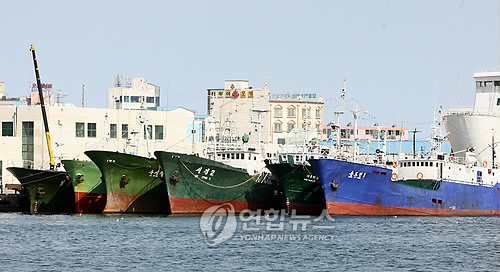As the international community, including China, sets about sanctioning North Korean vessels in line with a U.N. resolution, North Korea is seen scurrying to counter the movement by deactivating identification devices on its ships and banishing them from the map.
China plans to bar North Korean boats currently docked at its harbors from returning to their home ports starting Thursday, Japan’s Sankei Shimbun daily reported Wednesday, citing traders traversing between the two nations.
On top of an earlier ban imposed on North Korean vessels from entering the Dandong port near its border ahead of the resolution’s passage, Beijing is seeking an across-the-board entry embargo, it added.
China plans to bar North Korean boats currently docked at its harbors from returning to their home ports starting Thursday, Japan’s Sankei Shimbun daily reported Wednesday, citing traders traversing between the two nations.
On top of an earlier ban imposed on North Korean vessels from entering the Dandong port near its border ahead of the resolution’s passage, Beijing is seeking an across-the-board entry embargo, it added.

China has also denied the access of North Korean general cargo ship Grand Karo to the northeastern port of Rizhao, Reuters reported late Tuesday, quoting an unidentified official at the Rizhao Maritime Authority.
The Cambodia-flagged, 6,593-deadweight-ton freighter is among the 31 vessels blacklisted by the Security Council. It appears to be now anchored about 35 kilometers from Rizhao since last Wednesday, according to data from the Marine Traffic vessel tracking website, analyzed by The Korea Herald.
In an ostensible bid to evade tracking and possible seizures, a raft of North Korean ships have turned off their Automatic Identification Systems on board and vanished from the radar screen.
As of 6 p.m. Wednesday, the location of only 10 of the 31 were acknowledged on the website, including the Grand Karo and Jin Teng, which were impounded by the Philippines over the weekend. Of the remaining 21, 11 have disappeared since the UNSC adopted its fresh sanctions last Wednesday.
Aside from the Grand Karo, at least three more bulk carriers appear to have been denied entry to ports in China and Russia and thus were anchored in nearby waters, the website’s data showed.
The reports came as countries around the globe are setting in motion steps enshrined in the UNSC resolution while formulating their own penalties to prop up the measures.
South Korea on Tuesday slapped a fresh set of unilateral sanctions against the North, principally designed to further constrict Pyongyang’s financial and shipping networks.
Under the measures, foreign-flag vessels and flag-on-convenience ships owned in reality by North Korea will be prohibited from entering South Korea if they had stopped in the communist country within 180 days. They also cannot run an inter-Korean route.
Tokyo took a similar step last month on all North Korean and third-country-flagged vessels including on humanitarian missions.
On Saturday, the Philippines said it had seized a North Korean freighter that was blacklisted by the newest U.N. resolution, marking the first case of the measure’s implementation since its passage last Wednesday. The 6,830-deadweight-ton Jin Teng was flying a Sierra Leone flag and unloading palm kernels upon its arrival on Feb. 27, Manila’s Foreign Ministry said.
In particular, Beijing’s participation is deemed pivotal given that it takes up the majority of North Korea’s trade volume and has other options that could inflict a major damage on the already crumbling economy.
On land, China has also halted yuan transactions between its major banks and North Korean financial institutions, as well as dollar transfers to the North. It is expected to jack up the number of customs officers and carry out inspections on all exports to North Korea, the Japanese newspaper added.
Beijing’s swift implementation of the latest U.N. resolution and tightening of its own squeeze on Pyongyang may be intended to dilute global criticism for its staunch patronage of the defiant leadership despite its relentless provocations and nuclear development.
But it could also carry a message to the U.S. that is forecast to unveil its own standalone sanctions within the next couple weeks. The focal point will be whether it includes “secondary boycott” measures, which call for penalties for third-party companies and individuals engaging in transactions with the North, and would thus take a toll mostly on Chinese entities.
“I think the recent visit by Chinese Foreign Minister Wang Yi to Washington was probably multiple-thronged, including the denuclearization peace treaty talks and the envisioned stationing of a Terminal High Altitude Area Defense battery here,” a senior Seoul official said, requesting anonymity due to the sensitivity of the matter.
“But as Washington was gearing up for unilateral sanctions and considering the secondary boycotts, Wang could have sought to block the move, with China displaying its resolve for the resolution’s implementation and tightening its squeeze on the North on its own.”
By Shin Hyon-hee (heeshin@heraldcorp.com)







![[KH Explains] Hyundai's full hybrid edge to pay off amid slow transition to pure EVs](http://res.heraldm.com/phpwas/restmb_idxmake.php?idx=644&simg=/content/image/2024/04/18/20240418050645_0.jpg&u=20240419100350)






![[From the Scene] Monks, Buddhists hail return of remains of Buddhas](http://res.heraldm.com/phpwas/restmb_idxmake.php?idx=652&simg=/content/image/2024/04/19/20240419050617_0.jpg&u=20240419175937)

![[KH Explains] Hyundai's full hybrid edge to pay off amid slow transition to pure EVs](http://res.heraldm.com/phpwas/restmb_idxmake.php?idx=652&simg=/content/image/2024/04/18/20240418050645_0.jpg&u=20240419100350)

![[Today’s K-pop] Illit drops debut single remix](http://res.heraldm.com/phpwas/restmb_idxmake.php?idx=642&simg=/content/image/2024/04/19/20240419050612_0.jpg&u=)